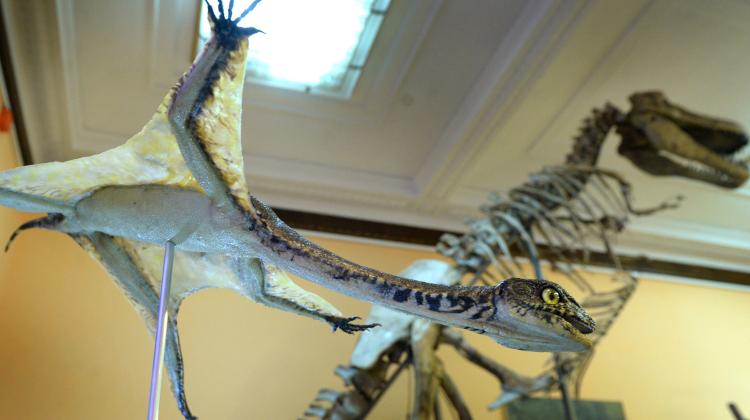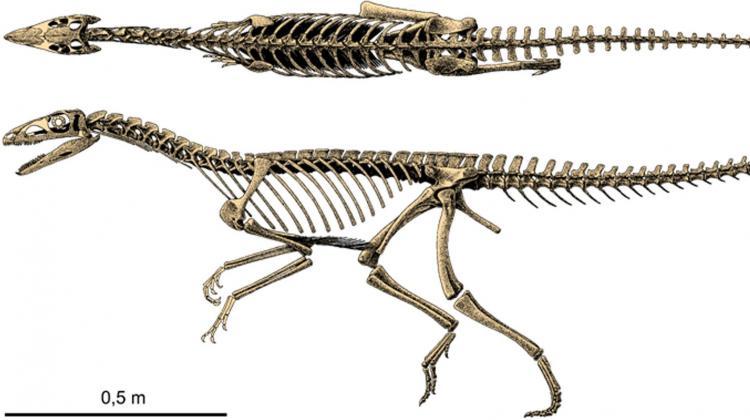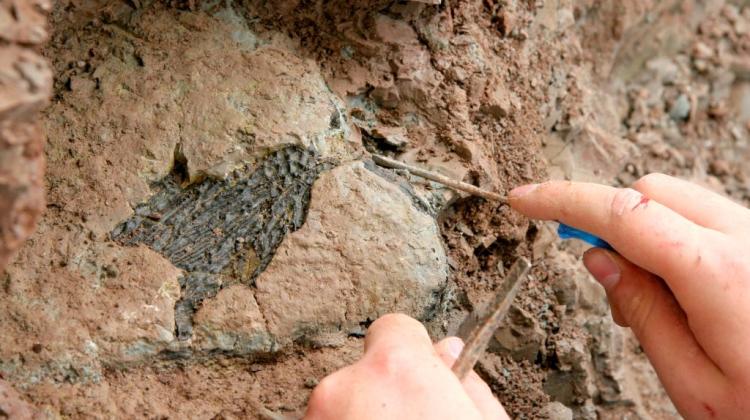Remains of a gliding reptile from the Triassic found in Krasiejów

The remains of gliding reptiles - from 230 million years ago - have been have discovered by Polish palaeontologists in Krasiejów (Opole province). The new species described by scientists - Ozimek volans - is the largest known flying reptile from such a distant past.
Ozimek volans was 90 cm in length, and its limb span was more than half a meter. It resembled a lizard with elongated legs between which was stretched the gliding membrane. The reptile had a long, active neck and elongated tail. It looked "a bit like a cross between a snake, a bat and a flying squirrel. This is why we were surprised when we discovered it" - Dr. Tomasz Sulej from the Institute of Paleobiology PAS in Warsaw said during press conference in Warsaw.
The first Ozimek bones were found in Krasiejów in 2001, the last in 2013 - said Dr. Sulej. Researchers have several fossils of whole skeletons and individual bones. Publication on the reptile was published last Monday in the journal "Acta Paleontologic Polonica". "Describing it took a very long time, because there was nothing like it anywhere in the world" - noted Sulej, one of the authors of the paper.
Head of the research project Prof. Jerzy Dzik, director of the Institute of Paleobiology PAS, explained that Ozimek volans - Ozimek\'s Flyer - was named after the town Ozimek (Opole province), near which lies Krasiejów, where the discovery was made.
"The animal was probably one of the ancestors of flying reptiles, and the largest gliding animal; no other can compare with it. Until something bigger is found, (ozimek - ed. PAP) can lay claim to the title of the king of the skies during the Triassic" - Prof. Dzik commented during the press conference. The researcher emphasised that ozimek was not a dinosaur, but relatively closely related to dinosaurs.
With favourable winds Ozimek would be able to soar in the air, but it would not be an active flight, as in the case of birds or bats. Ozimek was a glider - Dr. Sulej said in an interview with PAP. The ability to glide not only helped it hunt - probably insects, but mainly avoid predators. Sulej added that Polonosuchus could be a threat to Ozimek - the remains of these predatory reptiles were also found in Krasiejów.
Prof. Dzik pointed out that the bats - having developed the muscles in the thoracic part - use forelegs in-flight. Ozimek represented a different stage of evolution, in which "the forelimbs were not capable of active flight, and the main muscle mass was located in the pelvic area".
Researchers from the Institute of Paleobiology PAS added only after some time pterosaurs appeared on Earth - flying reptiles that had wing membranes on forelegs.
For now, there is no evidence that Ozimek belongs to the evolutionary line leading to the flying reptiles - admitted Prof. Dzik. Ozimek is in fact too dissimilar anatomically - to both primitive forms of flying reptiles and more advanced reptiles. "But we hope to find the location of the animal in the family tree of reptiles" - commented head of research.
The researchers hope that after the publication they will start getting reports of similar findings in other parts of the world. "I am sure that in the drawers of many researchers there are remains of animals similar to Ozimek" - commented Prof. Dzik and added that scientists could simply not yet know what sort of animal remains they had.
Palaeontologists found one of the bones of Ozimek in the brickyard in the commune Woźniki. "There could be more bones, but the new owner of the land does not allow to conduct excavations" - said Dr. Sulej. Such consent is required to conduct research.
Model of Ozimek and its bones can be seen from last Monday at the Museum of Evolution of the Institute of Paleobiology PAS in Warsaw.
PAP - Science and Scholarship in Poland
lt/ zan/
tr. RL
Przed dodaniem komentarza prosimy o zapoznanie z Regulaminem forum serwisu Nauka w Polsce.

















